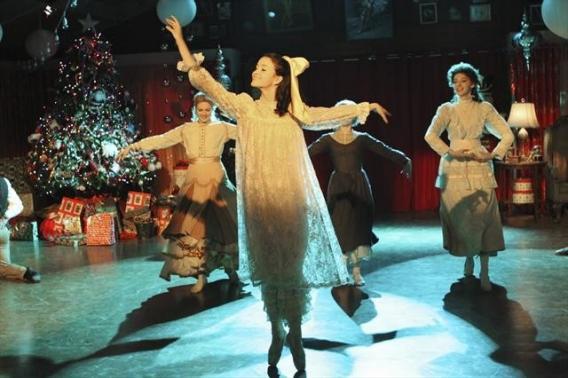Summer is here, the perfect time to catch up with a few of those shows everyone is always saying you should watch. But there are so many! How can you decide which to try? You need to find the gateway episode, one you can watch without any background knowledge and which will give you a real sense of the show—and whether you’ll like it.
To start, a confession: I was against watching Bunheads. My girlfriend had already introduced me to the seven-season masterpiece Gilmore Girls, but I was wary of Amy Sherman-Palladino’s new venture. Nestled alongside shows like Pretty Little Liars and Baby Daddy, Bunheads did not seem to be the show for the twentysomething male demographic.
I was wrong. Not only that, ABC Family was wrong to cancel the show yesterday after months of awkward equivocations, and Slate’s Willa Paskin and David Weigel are both right that it was one of the best shows on television. It seems grotesque to rush so quickly to the show’s last rites, so I first urge you to rant, Kickstart, and in every way campaign for its revival. If all else fails, Bunheads will at least merit immediate inclusion in the pantheon of Great One-Season Shows, beside series like Freaks and Geeks and Firefly.
Where to start, if you’re a skeptic, like I was? Not with the first episode. Bunheads is in particular need of the Gateway Episode treatment, as the pilot—a 44-minute fairytale gone wrong—stands alone with content that’s very different from the rest of the show. Michelle Sims (Sutton Foster) is a snarky Vegas showgirl whose ballet dancing dreams have been crushed. In an inebriated shotgun wedding, she marries Hubbell Flowers (Alan Ruck), a longtime suitor who whisks her away to Paradise, California, where he has a coastal property adjacent to his mother’s ballet school. Then Hubbell is killed in a car accident; Michelle is left stranded with his property, her mother-in-law Fanny, and the companionship of the precocious students of Paradise Dance Academy (whom she will now teach).
The subsequent episodes established Bunheads as a miraculous show, but the tenth—“A Nutcracker in Paradise”—was perhaps the past year’s best hour of television. As the last episode of ABC Family’s initial 10-episode order (the show was later renewed for an additional back end of 8 episodes), it possesses the heft and narrative import of a finale but still maintains the light, idiosyncratic touch that makes the show so enjoyable.
The premise: Fanny (Kelly Bishop, who Gilmore Girls fans know as the brilliantly acerbic Emily Gilmore) is rattled by the upcoming Nutcracker production, which functions as both the crowning performance of the year and the source of most of the school’s funding. Michelle has by now gained her trust as a dance instructor and confidante, so Fanny allows her daughter-in-law to choreograph the “Evil Mice Dance” of the show. Michelle opts for a more modern take:
Elsewhere in the episode, Sasha, the headstrong wunderkind who has historically played the lead Nutcracker role of Clara, has returned from her rebellious foray into cheerleading. She clashes with a teenage girl known only as “The Ringer”—a nameless, semi-stalking dancer Fanny has shipped down from San Francisco to replace her.
The other ballerinas are embroiled in a love triangle that Sasha sums up best: “Boo likes Charlie, Charlie likes Ginny, Melanie says Ginny can’t date Charlie because Boo liked him first, but Ginny thinks since Boo likes Carl she relinquishes Charlie, who should revert back to the open market, and me, I wish we were all lesbians.”
Lastly, Fanny has confided to Michelle her hopes to spend three rustic Montana months with her beau Michael—and, in a touching display of trust, she wants Michelle to run things in her stead. That trust is shattered when Michelle, through circumstances I won’t spoil, ends up accidentally macing all her dancers in the face. What follows features the Ringer’s last stand, a school of dancers treated at Paradise hospital, a surreal dream that confronts Michelle’s deepest insecurities, and a caustic fight between Michelle and Fanny that undermines their blossoming rapport. All in the last ten minutes.
The usual Sherman-Palladino staples abound: the episode is laden with pop-culture references (The Shining, Dead Poets Society, former U.N. Secretary-General Kofi Annan), the banter sparkles, and the dances are pitch-perfect. Bunheads is also, in the Sherman-Palladino mold, an unapologetically female-oriented show, but to focus on that misses the point: The writer-creator’s greatest talent, and one that is rarely mentioned, is her unfailing ability to portray both sides of a story, to redeem both sides of an argument, without compromising the sympathies of the audience. We are all privy to pressures—to conform, to please, to nurture, and to love—and these are the struggles that roil beneath the light comedy and self-aware sentimentality of the show. The four main dancers—imperial Sasha, frantic Boo, good-hearted Ginny, and fun-loving Melanie—were a quartet that captured a wide swath of adolescent turmoil, and through them Sherman-Palladino conjured all the petty fights and noble gestures that bind not just teenage girls, but all of us.
Previous Gateway Episodes
South Park
Happy Endings
The X-Files
The Sopranos
Gilmore Girls
Veronica Mars
Deadwood
Doctor Who
Buffy the Vampire Slayer
